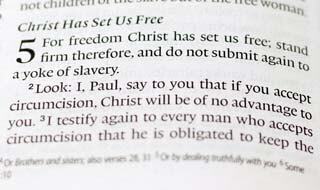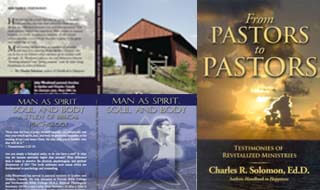Chapter 2: On Romans ch. 6 From Sin to Righteousness
CHAPTER 5 ended with grace on the Throne in the place of law. In chapter 6 the question is asked and answered; “Shall we sin that grace may abound?” Grace is a difficult thing to preach. When doing so, Paul strained all the superlatives in stating its boundlessness in the love of God, yet he was conscious of the danger of the corrupt human heart that would pervert that grace, and turn it into lasciviousness. Hence he turns from the statement as to how grace justifies the believer, to show how grace itself can be justified. He justifies justification by saying that grace and justification are not the allies of sin, but the destroyers of it; that grace not only removes the guilt of sin, but deals with sin itself, and produces holiness of life and character. In other words, that grace reigns unto life. Grace is on the Throne, so there is no place for license. It is true we are not under law, but we are still “under” — under grace. Grace wields the rule over us instead of sin, death or law. Grace brings life to none but those over whom it reigns. Therein grace and justification are justified.
In answer to the question, “Shall we continue in sin that grace may abount?” chapter 6 has four answers. (1) You cannot (verses 1-11); (2) You need not (verses 12-14); (3) You must not (verses 15-19); (4) You had better not (20-23). First Paul reasons with the one who asks the question, then he appeals to him, then he commands him, and finally he warns him! There is reasong, “you cannot”. There is appeal, “you need not”. There is command, “you must not”. There is warning, “you had better not!” That is one summary of the chapter. Notice a further one: “Continue in sin?” — it is impossible for those who have died to sin to live in it (verse 2). Verse 3 says it is a contradiction of our profession in baptism. Verse 4, it is inconsistent with our union with Christ; verses 5-7, it is a return to the old bondage; verses 9-11, it is a violation of the pattern of our life, which is to be in all things like Christ; verses 12-14, it is unnecessary, it robs God of His weapons in warfare against sin; verses 15-20, it would bring sin and Satan in again as master; verse 21, to continue in sin would outrage Christian conscience; verses 22-23, it would end in disaster. That is the complete summary of the chapter.
There are three ruling features in these answers with regard to being free from sin, mentioned in verses 17, 18 and 22. Sin in this chapter should always be with a capital letter, since it is not once mentioned as in the plural. Free from “sins” is not the subject, as in the earlier chapter where justification frees us from sins. It is something further, for it is emancipation from “Sin” as a master, tyrannizing over slaves. The treatment falls into three parts: verses 1 to 11; 12 to 14; 15 to 23. The first deals with the method of deliverance; the second with our appropriation of it by faith; the third with the purpose and result of our appropriation.
(1) The way in which freedom is secured is given in verses 1-11.
(2) That freedom is to be completely exercised and enjoyed (verses 12-14).
(3) The freedom is not to end in itself, but is a condition of something greater — a condition of holiness and life (15-23). The method of Deliverance
Let us look particularly at the method of deliverance. There is a parallel in the first eleven verses of Rom. 5 and of Rom 6. In the former we have set forth the implication of Christ’s death for us, but in the latter the implication of our death with Christ. Our knowledge of the method of freedom will not make it unnecessary to be in touch with the only One who can free us, that is, Jesus Christ. You cannot put the method into practice, it is only God can do that. Leave it to Him and to the Holy Spirit. Learning can never supplant faith. How, then, is freedom effected? By death! Death is the entrance into life, and it is by our own death. Deliverance from sin’s guilt and penalty is possible only by the death of Another for us, but deliverance from the thraldom of sin depends upon our death with Him. The only way of deliverance from sin is by dying to it, for by dying we pass into a realm where sin is not, where the break with it is complete and final.
Sin is contrary to the Christian’s own adopted and final attitude towards it, and it is contrary to God’s action in regard to the old man. You have the first attitude in the first five verses, and the second in the sixth, and so the subjective of the Christian is joined to the objective fact in Christ. That attitude of death is implied and symbolized in baptism. Then we died to sin — how then can we live in it? Sin is hated — not sins, but Sin, the tyrannical master. When we were baptized, did our baptism mean that we died to sin? If not, shall we let it mean that now? It speaks of union with Christ, one-ness, incorporation, association with Him. This union is a complete thing, for it is union with all that He is, in all His relationships. Union with Him in His death, in a clean cut with the old life. Entombment follows. Death and burial are the portals of resurrection, that “even so, we also should walk in newness of life” — new in quality, in nature, in character. I do not wonder that Paul prayed that he might know the “power of His resurrection”. There is no other power adequate for emancipation from sin, and for a life of holy service. That is the method through which resurrection power works. Get hold of that, and you will avoid disappointment and failure. Newness of life is a sure sequel, if we have died with Christ. Union with Him is a union in all things, right away to its consummation (verse 5). You begin with union with Christ in His death, and once united, you are carried right through into His resurrection. It will not be ours in all its fulness until this physical body is made like His glorified body. Then we shall be in all respects like Him even in body, for the ultimate end of this is a new body. This does not rob us of life in the present, but the “new body” represents the ultimate of the process.
“Our old man was crucified with Him, that the body of sin might be destroyed,” disabled, rendered impotent and inoperative. This body of sin is still a body of sin, even in the case of a believer. Sin’s propensities are in it. “Let not sin reign in your mortal body, that ye should obey it in the lusts thereof? (Rom. 6: 12). The body of the most advanced and spiritual Christian today is a “body of sin”. Sin, driven out from the throne of the will and the spirit, makes the body its stronghold. It is that fact of sin’s presence in the physical members which evokes the groan for the redemption of this body, to which reference is made in Rom. 8. The present fact of this body being a “body of sin”, and the future hope of the redemption of this body, are constantly before us in these chapters. There is no difficulty about the meaning of the “body of sin”. It seems to me that Paul uses it in the literal sense as referring to this sinful body – the “mortal body” of verse 12 with its desires. Crucified with Christ
What about the “old man”? The terms seems to be necessitated by the coming into being of the new man. Paul must find a term to describe somthing that was in him before the “new man” came into being. In Gal. 2: 20, he substitutes for it the capital “I” — “I was crucifed with Christ”. We might say the “old man” is the old personality, but it seems an exaggeration, for that means more than you want to say. In this connection Paul uses the word “flesh”. For years I confused the “old man” and “the flesh”, thinking them to be one and the same. Now I see that to be impossible, for there are two things predicated of the “old man”; (1) “Our old man was crucified with Christ” (Rom. 6: 6); and (2) in the epistles to the Ephesians and the Colossians, the old man is to be “put off”. Indeed, he says, it has been put off. Calvary is the place where the old man was crucified. We ourselves, as well as our sins, were taken there. The old man was executed as a hopeless criminal and rebel. This “old man” crucified is manifestly distinct from our death to sin. The “old man” does not die to sin, he dies in his sins. It needs a “new man” to die to sin. The “new man” agrees with God that the only place for the old man is the Cross, and so puts off the old man. The task of crucifying the “old man” is not left to us; God has done it, and we have to regard it as already done. But the “flesh” is left for the new man to crucify.( Gal. 5: 14). The “old man” is crucified, but his nature, his tendencies, his involuntary habits, remain. The “old man” has used the mechanism of our being for so long that out of sheer momentum it is apt to act involuntarily, and out of wonted habit to cry out for satisfaction. It is the “doings of the body” that we are called to put to death.( Rom. 8: 13, margin.).
The way of deliverance is indicated. We are justified from sin. No master can make a legal claim upon a servant who is dead. If he escapes and is caught, he might be made to answer a criminal charge, but a dead slave is free. Sin’s slaves are dead, and sin, as the old master, is compelled to recognize it. But the death of the slave is but one side of this matter. “For if we died with Christ, we believe that we shall also live with Him.” We share that life now. We need His life ere we can die to sin, and all that sin once meant to us, with Him. We need His life in order to reckon ourselves every day to be dead unto sin. Note again that this is not a dying unto sins, but to sin, that is why it is complete in one act. Dying to “sins” is not complete and final, it is something that goes on day after day. He died — so have we. He lives — so do we. That must be our constant reckoning. We have not done with the Cross, but we have done with dying to sin. This is the plain teaching of this passage.
Death and life! We reach the positive through the negative. Death is not the end, but the menas by which we enter life, and become “alive from the dead”. Our business is living, not dying, but we die in order to live, and to pass more and more into a greater and still greater fulness of life. Every point of the fuller life lies at the Cross.

















